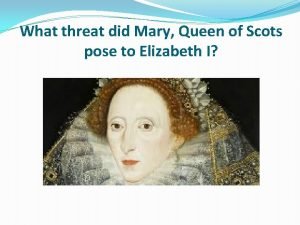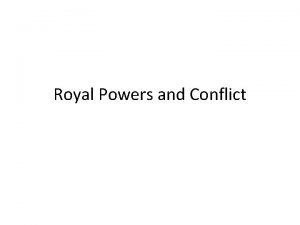Why was Mary Queen of Scots a threat

- Slides: 1

Why was Mary Queen of Scots a threat to Elizabeth I? Story Source Create a title for each paragraph. Summarise each paragraph in one or two bullet points. Mary Queen of Scots arrived in England in 1568. She had been forced to leave Scotland due to an uprising from Scottish nobles who had been unhappy with her marriage to Lord Bothwell (who had been accused of killing her second husband, Lord Darnley). She was forced to leave her son, and heir to throne, in Scotland. When she arrived in England she believed that her cousin Elizabeth I would help her to get her throne back. However, Elizabeth soon realised that Mary was a threat to her own throne and kept her prisoner. A Letter sent by Anthony Babington to Mary Stuart (July, 1586) We. . . will undertake the delivery of your royal persons from the hands of your enemies. . . For the dispatch of the usurper (Elizabeth). . . six noble gentlemen, who, for the zeal they have to the Catholic cause. . . will undertake that tragical execution. Letter sent by Mary Stuart to Anthony Babington (July, 1586) When all is ready, the six gentlemen must be set to work, and. . when it is accomplished, I may be in some way got away from here. . . then we will await foreign assistance. B In 1569 Elizabeth faced a serious rebellion in the north of England. The leaders of the rebellion, The Duke of Westmoreland the Duke of Northumberland were Catholic. Both felt that they had been overlooked by Elizabeth and decided to rebel against her and her religious settlement. They rode to Durham with 4, 500 men, stormed the cathedral and burnt the English Bible and destroyed the Protestant communion table. They then celebrated a Catholic mass, an act that was illegal in England. Part of their overall plan was to overthrow Elizabeth and replace her with Mary Queen of Scots, who was a Catholic. The rebels seized Durham and Barnard Castle but were defeated by royal troops. 800 rebels were executed and the leaders fled to Scotland. In 1570, the Pope excommunicated Elizabeth. In theory, Catholics no longer had to obey Elizabeth. Parliament became concerned that Catholics would plot and rise up against her and so in 1571 they passed a series of tough treason laws against Catholics. At this time, Mary was still a prisoner and became involved in the first plot against Elizabeth. A Catholic banker called Roberto Ridolfi tried to arrange the marriage of Mary Queen of Scots to the Duke of Norfolk, and overthrow Elizabeth so that the country could return to Catholicism. He had the support of Philip II of Spain. However the plot was discovered and the leaders executed. Mary continued to be held as a prisoner in England. In 1582 she was involved in another plot to overthrow Elizabeth. A Catholic called Francis Throckmorton was found to have plotted with Spanish priests and the Spanish ambassador to overthrow Elizabeth and put Mary in her place. Mary denied all knowledge of this, but was moved to a more secure location. In 1586, Elizabeth’s spymaster, Francis Walsingham discovered the Babington Plot which showed that Mary had directly plotted against Elizabeth. Mary had written letters to Sir Anthony Babington agreeing to a plan where Elizabeth would be assassinated and Mary put on the throne. The letters were written in code but Walsingham’s men cracked it. An embroidery made by Mary Queen of Scots while in captivity in England. It shows a large, ginger cat playing with a small grey mouse. Scholarship “As soon as Walsingham read Mary’s letter, he knew it to be far more incriminating than her earlier appeal to her foreign supporters before the Northern Rising. There she had spoken generally and allusively. Here she was almost explicit. Mary’s meaning is perfectly clear. She had consented to Elizabeth’s assassination and a foreign invasion. Strictly, she had not specified what the ‘work’ of the six gentlemen was to be, but the letter from Babington to which she was replying included the graphic passage, ‘For the dispatch of the usurper, from the obedience of whom we are by the excommunication of her made free, there be six noble gentlemen, all my private friends, who for the zeal they bear to the Catholic cause and your Majesty’s service will undertake that tragical execution. ’ When the two letters are read together, Mary’s complicity in the plot is undeniable. She protested at her trial that the evidence against her was purely circumstantial. ” From John Guy “Mary Queen of Scots, Film Tie in”, 2019 Task 1 Read through the story of Mary Qo. S’s imprisonment in England. For each paragraph, you need to create a ‘title’ on one side, and a short summary (two bullet points maximum) on the other. Task 2 Look at the sources A and B. In your book, write a short description of the message of each source. Then answer the question “What do these sources tell you about why Mary Queen of Scots was a threat to Elizabeth? ” Task 3 Read through the scholarship about MQo. S. Highlight 3 key sentences linked to why Mary was a threat to Elizabeth. In your book answer the question “What does John Guy think about Mary Queen of Scot’s involvements in the plots against Elizabeth? ”

